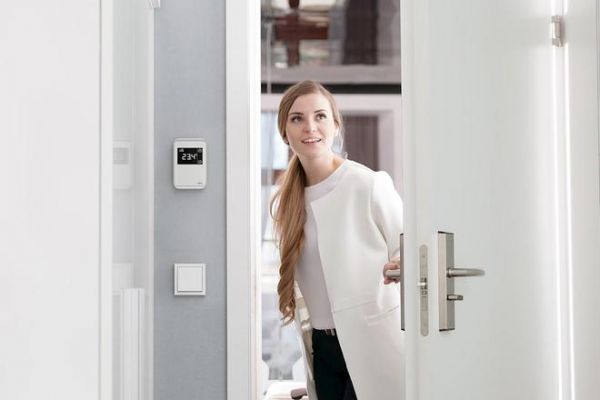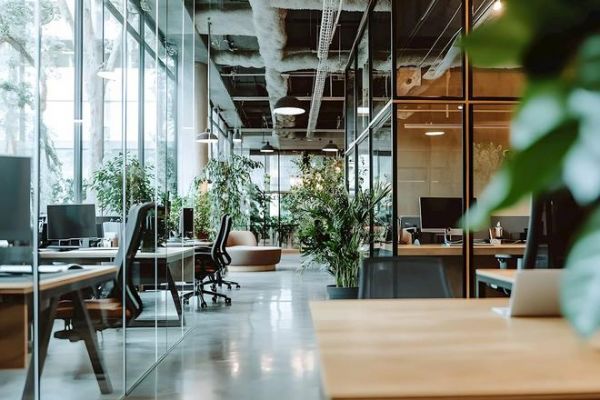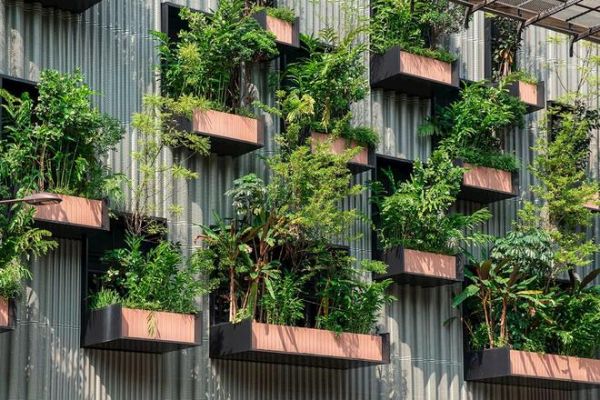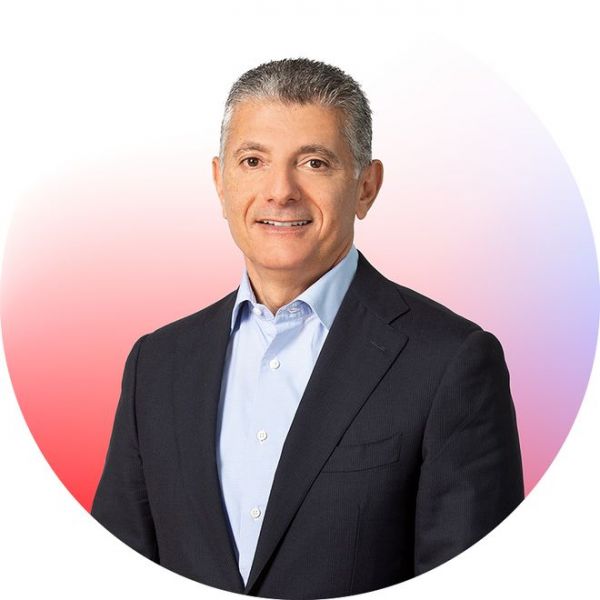呼吸建筑:健康舒适可持续
Smart Buildings: Beyond Energy Efficiency Smart Buildings: Beyond Energy Efficiency
We often discuss the energy efficiency and emissions of buildings, but rarely do we talk about their impact on cognitive clarity, work efficiency, sleep quality, and stress levels. It's time to broaden the scope of our discussions.
The spaces where we live, work, and learn are crucial to our health. We spend 90% of our time indoors, and the air, light, and temperature of our environment directly affect how we feel and function. Smart buildings are no longer just about energy; they are becoming a key carrier for improving human well-being.
Warm Technology
When buildings are equipped with smart interconnect systems, the benefits are clear:
Improved Indoor Air Quality (IAQ): IoT sensors can reduce indoor carbon dioxide levels by up to 30%, helping to think more clearly and make faster decisions. A study by the WorldGBC shows that improving ventilation can create about $400 in value for each employee per year. Personalized Comfort Experience: Proven that lighting and HVAC systems controlled by residents can increase comfort and work efficiency by 20%. Energy Efficiency Performance: Up to 25% in energy savings can be achieved while ensuring indoor air quality.This is the embodiment of technology with a human touch, where sustainability and human care are intertwined.

ABB Smart Sensor FusionAir
Link between Productivity and Health Status
The impact of indoor environment on cognitive ability and health is profound. A Harvard University study found that severe indoor air pollution can lead to decreased cognitive function, slower reaction times, and increased fatigue among office workers. Poor air quality is also associated with headaches, respiratory problems, and increased absenteeism.
In contrast, optimizing air quality, lighting, and temperature in smart buildings can increase comfort by 30% and directly correlate to a 20% increase in productivity. Buildings certified under the WELL Health Building Standard also report a 15% decrease in sick days and a 10% increase in productivity.
Bio-philic Design: A Strategic Advantage
Building standards are increasingly confirming the fact that has long been proven by high-intelligence buildings: health and sustainability complement each other. Bio-philic design – integrating natural elements into buildings to connect people with nature – is becoming a core strategy of the upcoming LEED v5 standard, further enhancing the health and satisfaction of residents.
The new "occupant experience" metrics encourage a comprehensive approach to improve comfort, daylighting, and adaptability to the environment. When these methods are combined with the core electrical and intelligent automation of ABB solutions, the effect is even more significant.

When smart automation meets nature, it helps improve health and efficiency
Reduce Energy Consumption: Bio-philic designs such as green roofs, natural ventilation, and natural lighting reduce reliance on artificial systems. Combined with efficient electrification technologies (such as heat pumps and smart lighting), these systems can reduce emissions and achieve more intelligent energy use. Healthier Indoor Environment: Electrification eliminates the combustion of fossil fuels in buildings, significantly improving air quality and reducing health risks. At the same time, bio-philic elements further filter the air and balance humidity, which is beneficial for respiratory health. Improve Comfort and Productivity: Smart automation systems can dynamically adjust lighting, temperature, and airflow according to the needs of residents and natural conditions, ensuring comfort and focus while reducing energy waste. This synergistic effect can increase comfort and productivity by up to 20%. Energy Efficiency: Integrated systems with resident data, environmental sensors, and bio-philic elements can help buildings adjust in real-time, maximizing comfort while minimizing unnecessary energy use.Open Systems, Open Outcomes
To achieve scalable impact, systems must work together. Open standards such as KNX and Matter, as well as platforms that encourage interoperability, make it possible to balance comfort, sustainability, and cost-effectiveness. At ABB, this open approach is at the core of our partnerships and solutions, making seamless integration of electrification, bio-philic design, and intelligent automation possible.
When systems are open, the benefits are not only for operators and owners, but for everyone who enters the space.
Healthy Buildings, Stronger Returns
Healthy buildings are not only beneficial to people but also more valuable. Studies have shown that healthy buildings can bring higher rents, reduce vacancy rates, and this is due to their ability to attract and retain talent, and reduce operating costs. They are becoming new benchmarks.
Investors and tenants are increasingly focusing on buildings that can bring real health and comfort benefits.
Predictive maintenance enabled by the Internet of Things can reduce downtime and ensure the reliable operation of key systems such as ventilation, thereby protecting the health and business continuity of residents. By understanding the use of space in real time, space utilization can be improved, making smart buildings flexible, adjusting layouts, lighting, and systems to adapt to people's actual work and lifestyle. Attention to indoor air quality (IAQ) is also becoming a differentiating advantage. For example, ABB's smart IAQ sensors can help building operators monitor and address air quality issues in real time. A recent study by the MIT Real Estate Innovation Lab found that "healthy buildings" certified under WELL or FITWEL can increase effective rent per square foot by up to 7.7%.
Urbanization and Future Demand
Urbanization is one of the most powerful trends shaping the future development of the global building industry. The United Nations predicts that the urban population will increase by 1.35 billion by 2030, which will drive unprecedented demand for new and upgraded infrastructure, including smarter, healthier, and more efficient buildings.
It is expected that urban expansion will add 12 million square kilometers of urban land by 2030, an area almost the size of South Africa. In many regions, especially in Asia and Africa, the coverage of urban land is expected to grow several times, which will drive a massive construction boom and create a demand for innovative building solutions. The rapid urban development not only changes the skyline but also changes our thinking about resource management, resident well-being, and sustainability.
Smart buildings are the core response to urbanization. With the increasing urban density, the integration of smart systems such as the Internet of Things, electrification, and automation makes buildings more efficient in energy use, support a healthier lifestyle, and adapt to the changing needs of the urban population.
Solutions
Smart buildings and open interoperable systems can maximize efficiency, comfort, and sustainability, helping cities not only to grow but also to thrive. As the urbanization process accelerates, the demand for buildings that can "breathe", that is, both adapt to human life and adapt to the environment of the earth, will increase day by day.
Upcoming Events Highlighting This Shift
These global events highlight the momentum of the industry around "health-first, technology-enabled" buildings:
LEED v5 Release: Expected to be released this year, focusing more on the well-being of occupants and bio-philic design. NexusCon 2025: October 6, 2025, in Denver, dedicated to accelerating the digitalization and decarbonization transformation of the building industry. World Energy Week: October 6-9, in Panama, focusing on "Promoting Energy Connections, Building a Healthy Planet," to build a "Healthy Planet" for billions of lives.Design for People
In a world increasingly affected by climate change, urbanization, and evolving workplace expectations, we have a responsibility not just to design for compliance, but to design for care.
The progress of smart buildings does not come from innovation alone; it comes from a common goal. Because if our buildings can help people breathe more easily, think more clearly, and feel more comfortable, then what we are promoting is not just intelligent technology, but the release of human potential.
At ABB, we are committed to creating spaces that can adapt to needs, provide support, and inspire.
We do not design for buildings; we design for people.
About the Author
Mike Mustapha

Mike Mustapha is currently the President of ABB's Global Smart Buildings Division, appointed in February 2022. In this role, he is fully responsible for ABB's global smart buildings business, which covers market-leading smart home and building automation solutions, as well as the terminal distribution system product portfolio. In 1990, Mustapha began his career in the United States as an application engineer for Rotoflow, a leading supplier of high-speed rotating and cryogenic equipment for process industries. Since then, he has held various leadership positions in multinational industrial companies such as Atlas Copco, accumulating global management experience. In January 2009, Mustapha founded a prefabricated building and hot-rolled structural steel group in Jeddah, Saudi Arabia, with an independent board of directors, fully responsible for company affairs, and overseeing operations in the Middle East. Mustapha joined ABB in August 2011 as the Regional Manager for the Low Voltage Business Unit in India, Middle East, and Africa. In June 2014, he was promoted to Global Head of the Building Products Business Unit, and in 2018, he was appointed as the Global Market Leader of the Electrical Division. Mustapha currently resides in Dubai and holds a Master's degree in Mechanical Engineering from the University of Southern California (USC).
About ABB
ABB is a global technology leader in electrical and automation, dedicated to empowering a more sustainable and efficient future. By combining engineering expertise with digital technology, ABB helps industries operate more efficiently, improve energy and production efficiency, promote sustainability, achieve excellence, and strive for the farthest.
ABB has a history of more than 140 years, with approximately 110,000 employees worldwide. ABB is listed on the SIX Swiss Exchange (ABBN) and the Nasdaq Stockholm (ABB).
ABB has comprehensive business activities in China, including research and development, manufacturing, sales, and engineering services. With approximately 30 local enterprises, about 15,000 employees are distributed in nearly 130 cities, and online and offline channels cover about 700 cities across the country.
相关知识
会“呼吸”的建筑:健康、舒适与可持续优势
呼吸建筑:健康舒适可持续
呼吸健康莫大意!博洛尼携手网易公益发起「健康呼吸计划」,打造可持续环保生活方式
舒适家居快讯|江森自控垂恩(TRION)空气净化解决方案助力建筑健康
杜绝“甲醛房”,丽可洁专业除甲醛,守护家庭呼吸健康
让健康从呼吸开始,奥克斯机芯可拆洗空调首发
圣戈班章轩:关注低碳环保,深耕可持续建筑领域
飞利浦空调产品篇:全场景覆盖,重塑舒适健康呼吸
松下新风:营造会“呼吸”的健康舒适家
2024年第三届可持续设计峰会在上海召开:探索零售、酒店、金融、建筑与科技的可持续未来
网址: 呼吸建筑:健康舒适可持续 http://m.jiajubaike.cn/newsview135207.html